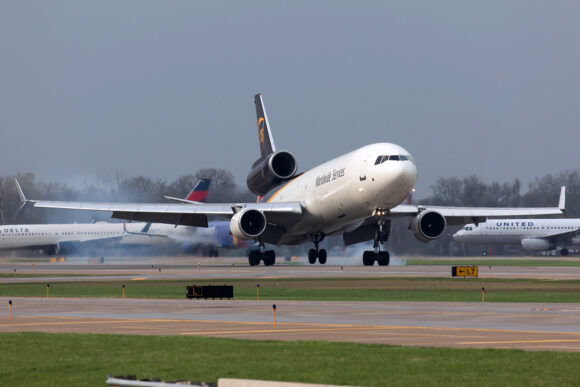The United Parcel Service Inc. freighter that crashed this month when the left engine detached just after takeoff showed fatigue cracks in several sections that secured the turbine, a preliminary report into the accident that killed 14 people revealed.
National Transportation Safety Board investigators found “evidence of fatigue cracks in addition to areas of overstress failure,” the agency said in the findings released Thursday.
The McDonnell Douglas MD-11F lost its left engine during takeoff from the courier’s main hub in Louisville, Kentucky, and didn’t climb higher than 30 feet before crashing, the report said. Those killed included the crew and people on the ground.
Dramatic images in the preliminary report show the engine and its pylon detaching and rocketing into the air in a fireball almost immediately after takeoff. The report is the first detailed account of the Nov. 4 crash.
The circumstances surrounding the UPS crash are “eerily similar” to a 1979 accident involving a McDonnell Douglas DC-10 flown by American Airlines Group Inc. that crashed after the left engine detached from the plane shortly after takeoff, said Jeff Guzzetti, a former accident investigation chief for the US Federal Aviation Administration. However, the structural failure occurred in slightly different locations, he said.
In addition, the NTSB determined the American Airlines crash was caused by damage from improper maintenance. But the agency’s initial findings in the UPS probe don’t point to any damage caused by obvious external factors, other than aging, Guzzetti said.
After the UPS accident, the FAA temporarily grounded all MD-11F cargo jets, pending inspections and certain corrective actions by operators.
It’s since expanded that directive to other aircraft with similar engine-pylon designs. The grounding affects roughly 9% of UPS’ fleet and about 4% of rival FedEx Corp.’s.
UPS said in a statement Thursday that prior to the FAA’s directive, it grounded its MD-11 fleet “out of an abundance of caution.” The carrier and Boeing Co., which took over McDonnell Douglas in 1997, said they would continue supporting the probe.
Investigators have been trying to determine how the engine and pylon detached so soon after takeoff. They’ve previously said they’re looking at a number of areas as part of their probe, including maintenance conducted on the plane several weeks prior.
The NTSB’s report shows that a detailed visual inspection of the left engine mount structure was performed in October 2021. Another more intensive inspection of the particular part that failed in the crash wasn’t due for another 8,000 takeoffs and landings.
“That’s what the initial design and maintenance requirements called for,” Guzzetti said. “But this part failed long before that interval,” he said.
While the preliminary report can offer clues on how the crash occurred, definitive conclusions could take anywhere from one to two years to reach.
The specific plane involved in the the crash was originally built for Thai Airways International in the early 1990s before being converted into a freighter about 20 years ago. The plane was powered by three General Electric Co. CF6 engines.
The MD-11 is long out of production and only flown for cargo operations today. The last passenger flight took place more than a decade ago.
Photo: A UPS MD-11 plane, similar to the one that crashed in Louisville Nov. 4. (AdobeStock)
Was this article valuable?
Here are more articles you may enjoy.



 Acrisure to Buy MGA Vave From Canopius
Acrisure to Buy MGA Vave From Canopius  Trump to Issue Order Creating National AI Rule
Trump to Issue Order Creating National AI Rule  Dunkin’ Cashier in Georgia, Stabbed by Rapper, Can’t Claim More Than Workers’ Comp
Dunkin’ Cashier in Georgia, Stabbed by Rapper, Can’t Claim More Than Workers’ Comp  State Farm Sued Over Policies Backed by Distressed Insurer PHL
State Farm Sued Over Policies Backed by Distressed Insurer PHL 

